Alan Joyce's Leadership at Qantas
VerifiedAdded on 2020/04/01
|6
|2140
|140
AI Summary
The assignment examines Alan Joyce's leadership at Qantas, specifically highlighting his transactional leadership style. It discusses how he took responsibility for mistakes, made corrective decisions, and transformed Qantas into a more profitable and customer-oriented organization. The analysis also explores his balanced approach to internal and external issues, communication strategies, and decision-making process.
Contribute Materials
Your contribution can guide someone’s learning journey. Share your
documents today.
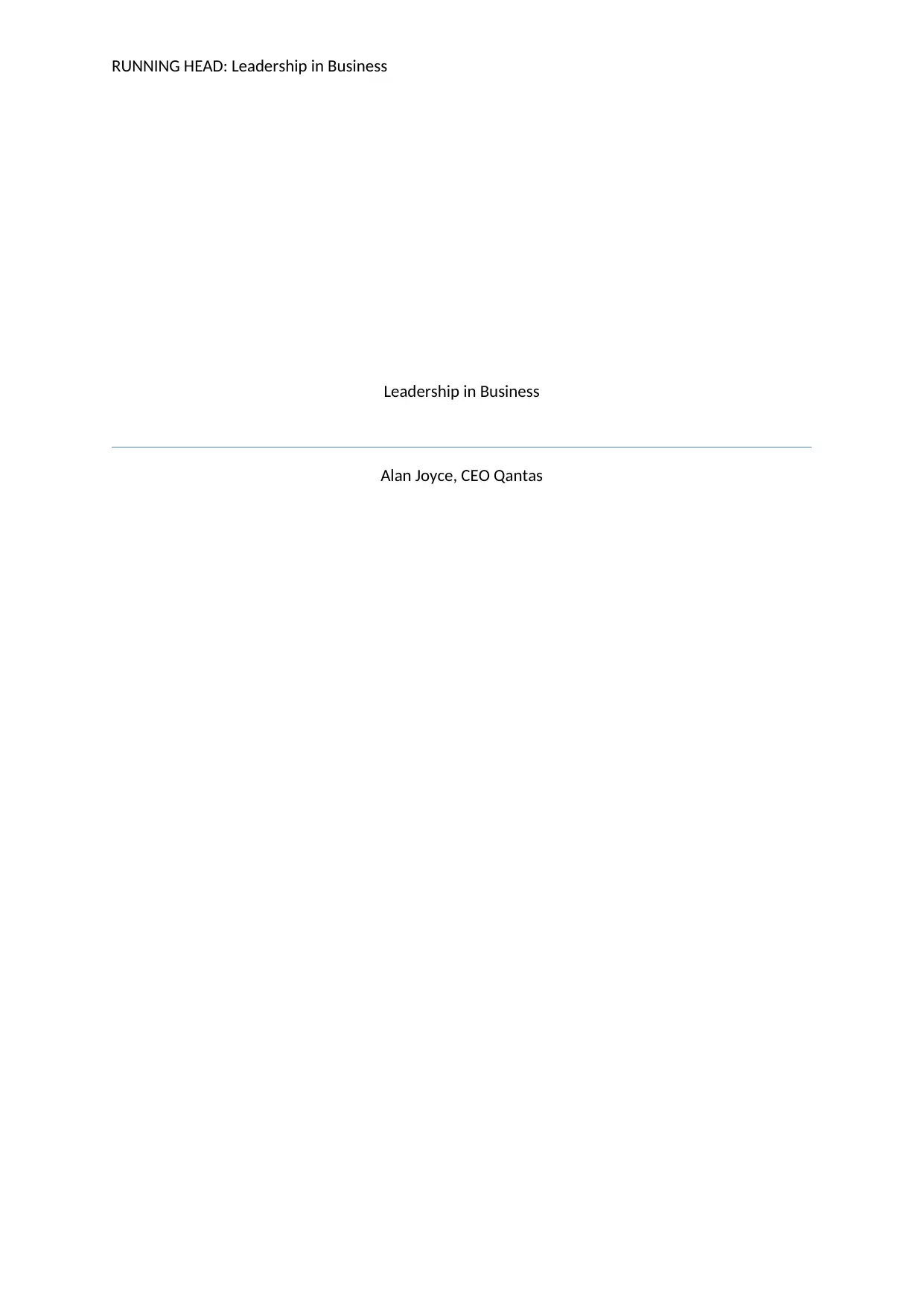
RUNNING HEAD: Leadership in Business
Leadership in Business
Alan Joyce, CEO Qantas
Leadership in Business
Alan Joyce, CEO Qantas
Secure Best Marks with AI Grader
Need help grading? Try our AI Grader for instant feedback on your assignments.
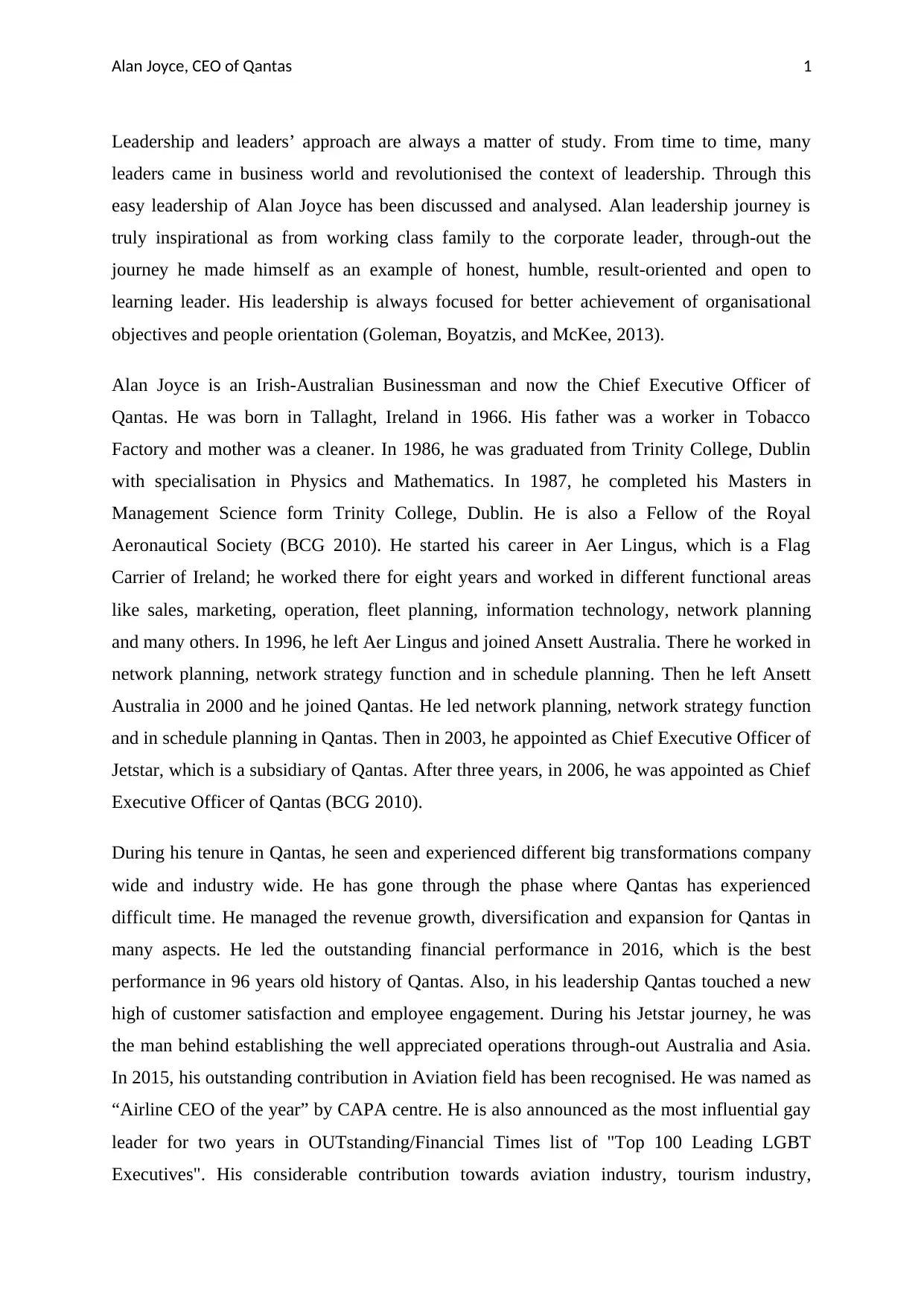
Alan Joyce, CEO of Qantas 1
Leadership and leaders’ approach are always a matter of study. From time to time, many
leaders came in business world and revolutionised the context of leadership. Through this
easy leadership of Alan Joyce has been discussed and analysed. Alan leadership journey is
truly inspirational as from working class family to the corporate leader, through-out the
journey he made himself as an example of honest, humble, result-oriented and open to
learning leader. His leadership is always focused for better achievement of organisational
objectives and people orientation (Goleman, Boyatzis, and McKee, 2013).
Alan Joyce is an Irish-Australian Businessman and now the Chief Executive Officer of
Qantas. He was born in Tallaght, Ireland in 1966. His father was a worker in Tobacco
Factory and mother was a cleaner. In 1986, he was graduated from Trinity College, Dublin
with specialisation in Physics and Mathematics. In 1987, he completed his Masters in
Management Science form Trinity College, Dublin. He is also a Fellow of the Royal
Aeronautical Society (BCG 2010). He started his career in Aer Lingus, which is a Flag
Carrier of Ireland; he worked there for eight years and worked in different functional areas
like sales, marketing, operation, fleet planning, information technology, network planning
and many others. In 1996, he left Aer Lingus and joined Ansett Australia. There he worked in
network planning, network strategy function and in schedule planning. Then he left Ansett
Australia in 2000 and he joined Qantas. He led network planning, network strategy function
and in schedule planning in Qantas. Then in 2003, he appointed as Chief Executive Officer of
Jetstar, which is a subsidiary of Qantas. After three years, in 2006, he was appointed as Chief
Executive Officer of Qantas (BCG 2010).
During his tenure in Qantas, he seen and experienced different big transformations company
wide and industry wide. He has gone through the phase where Qantas has experienced
difficult time. He managed the revenue growth, diversification and expansion for Qantas in
many aspects. He led the outstanding financial performance in 2016, which is the best
performance in 96 years old history of Qantas. Also, in his leadership Qantas touched a new
high of customer satisfaction and employee engagement. During his Jetstar journey, he was
the man behind establishing the well appreciated operations through-out Australia and Asia.
In 2015, his outstanding contribution in Aviation field has been recognised. He was named as
“Airline CEO of the year” by CAPA centre. He is also announced as the most influential gay
leader for two years in OUTstanding/Financial Times list of "Top 100 Leading LGBT
Executives". His considerable contribution towards aviation industry, tourism industry,
Leadership and leaders’ approach are always a matter of study. From time to time, many
leaders came in business world and revolutionised the context of leadership. Through this
easy leadership of Alan Joyce has been discussed and analysed. Alan leadership journey is
truly inspirational as from working class family to the corporate leader, through-out the
journey he made himself as an example of honest, humble, result-oriented and open to
learning leader. His leadership is always focused for better achievement of organisational
objectives and people orientation (Goleman, Boyatzis, and McKee, 2013).
Alan Joyce is an Irish-Australian Businessman and now the Chief Executive Officer of
Qantas. He was born in Tallaght, Ireland in 1966. His father was a worker in Tobacco
Factory and mother was a cleaner. In 1986, he was graduated from Trinity College, Dublin
with specialisation in Physics and Mathematics. In 1987, he completed his Masters in
Management Science form Trinity College, Dublin. He is also a Fellow of the Royal
Aeronautical Society (BCG 2010). He started his career in Aer Lingus, which is a Flag
Carrier of Ireland; he worked there for eight years and worked in different functional areas
like sales, marketing, operation, fleet planning, information technology, network planning
and many others. In 1996, he left Aer Lingus and joined Ansett Australia. There he worked in
network planning, network strategy function and in schedule planning. Then he left Ansett
Australia in 2000 and he joined Qantas. He led network planning, network strategy function
and in schedule planning in Qantas. Then in 2003, he appointed as Chief Executive Officer of
Jetstar, which is a subsidiary of Qantas. After three years, in 2006, he was appointed as Chief
Executive Officer of Qantas (BCG 2010).
During his tenure in Qantas, he seen and experienced different big transformations company
wide and industry wide. He has gone through the phase where Qantas has experienced
difficult time. He managed the revenue growth, diversification and expansion for Qantas in
many aspects. He led the outstanding financial performance in 2016, which is the best
performance in 96 years old history of Qantas. Also, in his leadership Qantas touched a new
high of customer satisfaction and employee engagement. During his Jetstar journey, he was
the man behind establishing the well appreciated operations through-out Australia and Asia.
In 2015, his outstanding contribution in Aviation field has been recognised. He was named as
“Airline CEO of the year” by CAPA centre. He is also announced as the most influential gay
leader for two years in OUTstanding/Financial Times list of "Top 100 Leading LGBT
Executives". His considerable contribution towards aviation industry, tourism industry,
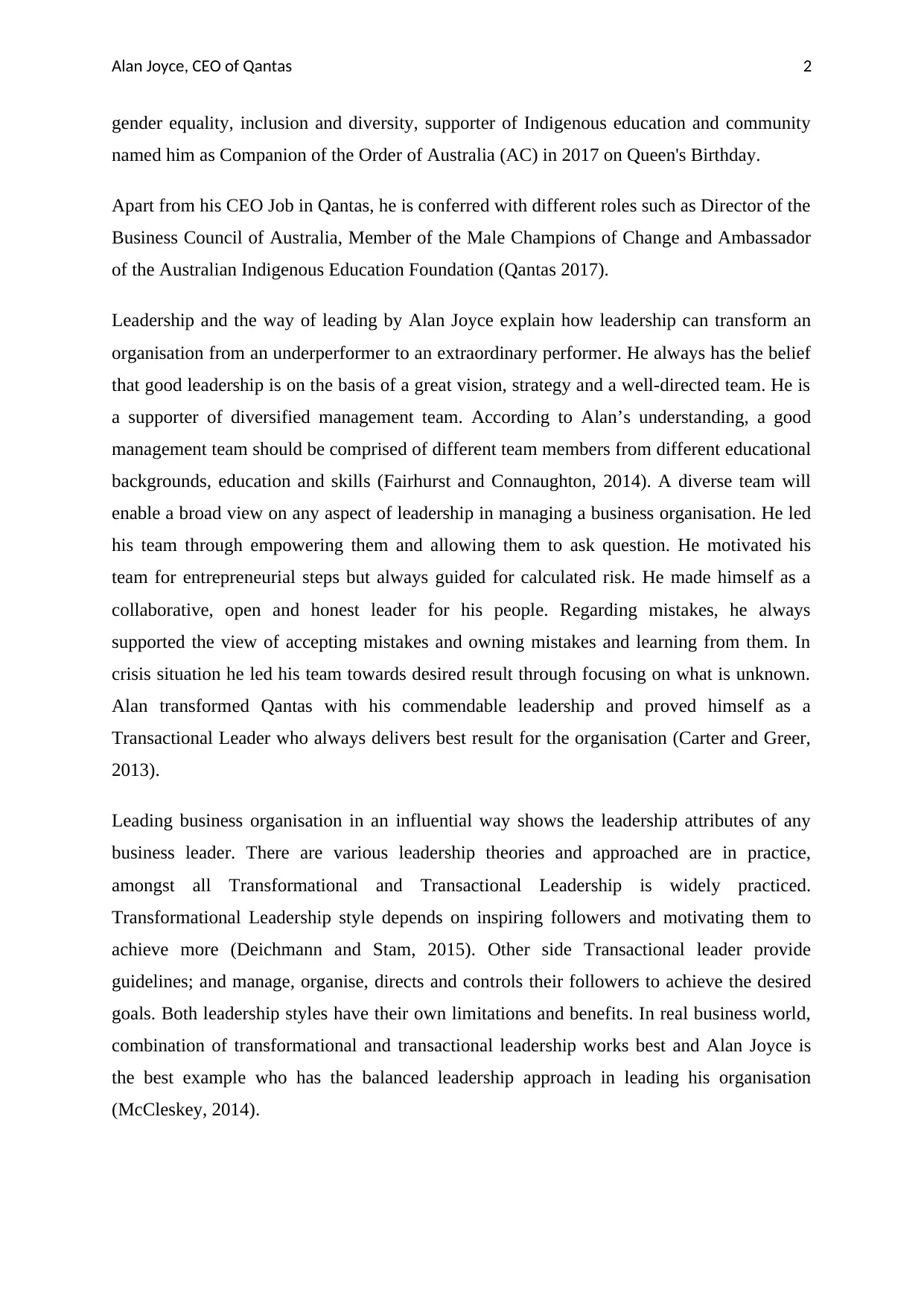
Alan Joyce, CEO of Qantas 2
gender equality, inclusion and diversity, supporter of Indigenous education and community
named him as Companion of the Order of Australia (AC) in 2017 on Queen's Birthday.
Apart from his CEO Job in Qantas, he is conferred with different roles such as Director of the
Business Council of Australia, Member of the Male Champions of Change and Ambassador
of the Australian Indigenous Education Foundation (Qantas 2017).
Leadership and the way of leading by Alan Joyce explain how leadership can transform an
organisation from an underperformer to an extraordinary performer. He always has the belief
that good leadership is on the basis of a great vision, strategy and a well-directed team. He is
a supporter of diversified management team. According to Alan’s understanding, a good
management team should be comprised of different team members from different educational
backgrounds, education and skills (Fairhurst and Connaughton, 2014). A diverse team will
enable a broad view on any aspect of leadership in managing a business organisation. He led
his team through empowering them and allowing them to ask question. He motivated his
team for entrepreneurial steps but always guided for calculated risk. He made himself as a
collaborative, open and honest leader for his people. Regarding mistakes, he always
supported the view of accepting mistakes and owning mistakes and learning from them. In
crisis situation he led his team towards desired result through focusing on what is unknown.
Alan transformed Qantas with his commendable leadership and proved himself as a
Transactional Leader who always delivers best result for the organisation (Carter and Greer,
2013).
Leading business organisation in an influential way shows the leadership attributes of any
business leader. There are various leadership theories and approached are in practice,
amongst all Transformational and Transactional Leadership is widely practiced.
Transformational Leadership style depends on inspiring followers and motivating them to
achieve more (Deichmann and Stam, 2015). Other side Transactional leader provide
guidelines; and manage, organise, directs and controls their followers to achieve the desired
goals. Both leadership styles have their own limitations and benefits. In real business world,
combination of transformational and transactional leadership works best and Alan Joyce is
the best example who has the balanced leadership approach in leading his organisation
(McCleskey, 2014).
gender equality, inclusion and diversity, supporter of Indigenous education and community
named him as Companion of the Order of Australia (AC) in 2017 on Queen's Birthday.
Apart from his CEO Job in Qantas, he is conferred with different roles such as Director of the
Business Council of Australia, Member of the Male Champions of Change and Ambassador
of the Australian Indigenous Education Foundation (Qantas 2017).
Leadership and the way of leading by Alan Joyce explain how leadership can transform an
organisation from an underperformer to an extraordinary performer. He always has the belief
that good leadership is on the basis of a great vision, strategy and a well-directed team. He is
a supporter of diversified management team. According to Alan’s understanding, a good
management team should be comprised of different team members from different educational
backgrounds, education and skills (Fairhurst and Connaughton, 2014). A diverse team will
enable a broad view on any aspect of leadership in managing a business organisation. He led
his team through empowering them and allowing them to ask question. He motivated his
team for entrepreneurial steps but always guided for calculated risk. He made himself as a
collaborative, open and honest leader for his people. Regarding mistakes, he always
supported the view of accepting mistakes and owning mistakes and learning from them. In
crisis situation he led his team towards desired result through focusing on what is unknown.
Alan transformed Qantas with his commendable leadership and proved himself as a
Transactional Leader who always delivers best result for the organisation (Carter and Greer,
2013).
Leading business organisation in an influential way shows the leadership attributes of any
business leader. There are various leadership theories and approached are in practice,
amongst all Transformational and Transactional Leadership is widely practiced.
Transformational Leadership style depends on inspiring followers and motivating them to
achieve more (Deichmann and Stam, 2015). Other side Transactional leader provide
guidelines; and manage, organise, directs and controls their followers to achieve the desired
goals. Both leadership styles have their own limitations and benefits. In real business world,
combination of transformational and transactional leadership works best and Alan Joyce is
the best example who has the balanced leadership approach in leading his organisation
(McCleskey, 2014).
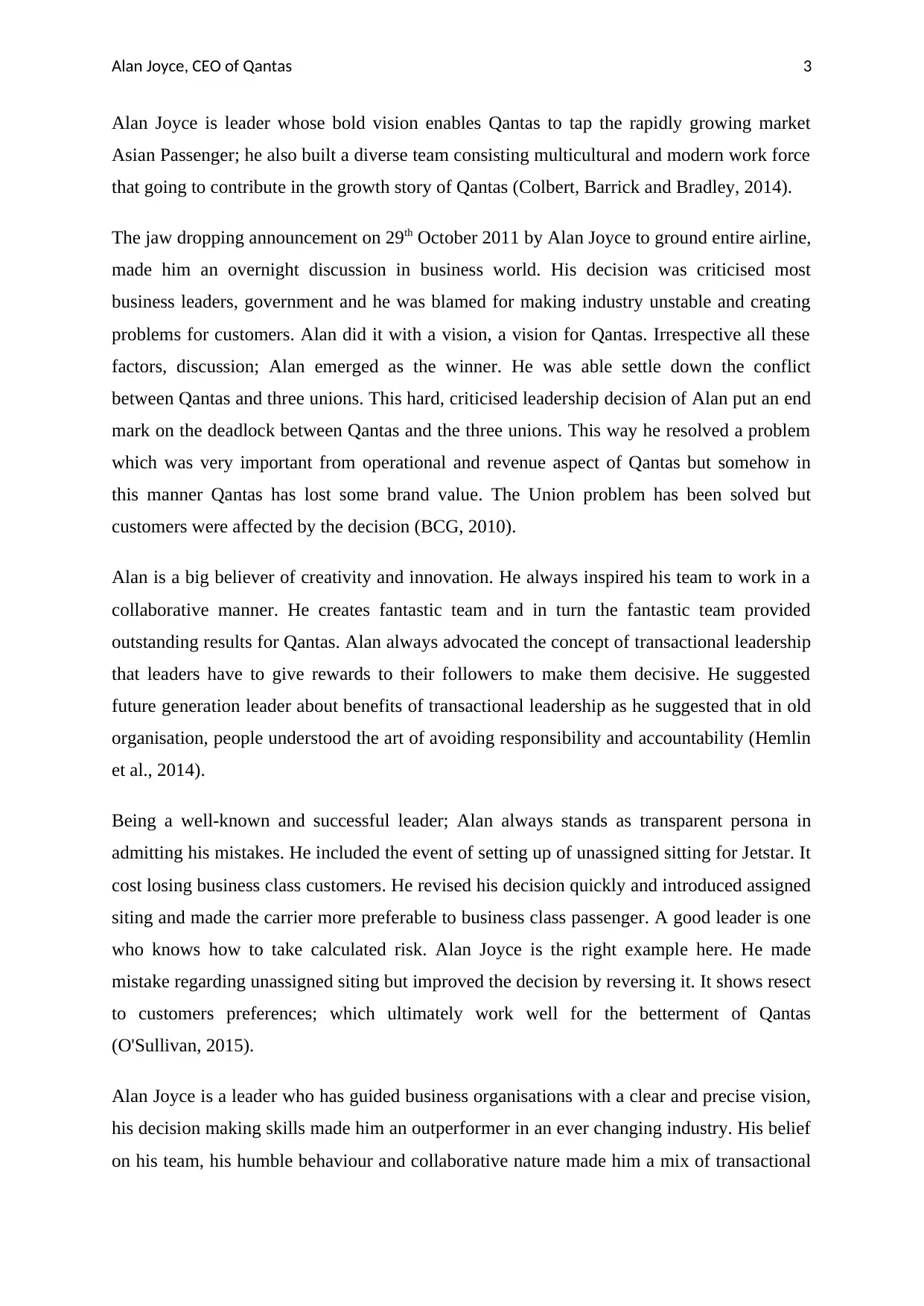
Alan Joyce, CEO of Qantas 3
Alan Joyce is leader whose bold vision enables Qantas to tap the rapidly growing market
Asian Passenger; he also built a diverse team consisting multicultural and modern work force
that going to contribute in the growth story of Qantas (Colbert, Barrick and Bradley, 2014).
The jaw dropping announcement on 29th October 2011 by Alan Joyce to ground entire airline,
made him an overnight discussion in business world. His decision was criticised most
business leaders, government and he was blamed for making industry unstable and creating
problems for customers. Alan did it with a vision, a vision for Qantas. Irrespective all these
factors, discussion; Alan emerged as the winner. He was able settle down the conflict
between Qantas and three unions. This hard, criticised leadership decision of Alan put an end
mark on the deadlock between Qantas and the three unions. This way he resolved a problem
which was very important from operational and revenue aspect of Qantas but somehow in
this manner Qantas has lost some brand value. The Union problem has been solved but
customers were affected by the decision (BCG, 2010).
Alan is a big believer of creativity and innovation. He always inspired his team to work in a
collaborative manner. He creates fantastic team and in turn the fantastic team provided
outstanding results for Qantas. Alan always advocated the concept of transactional leadership
that leaders have to give rewards to their followers to make them decisive. He suggested
future generation leader about benefits of transactional leadership as he suggested that in old
organisation, people understood the art of avoiding responsibility and accountability (Hemlin
et al., 2014).
Being a well-known and successful leader; Alan always stands as transparent persona in
admitting his mistakes. He included the event of setting up of unassigned sitting for Jetstar. It
cost losing business class customers. He revised his decision quickly and introduced assigned
siting and made the carrier more preferable to business class passenger. A good leader is one
who knows how to take calculated risk. Alan Joyce is the right example here. He made
mistake regarding unassigned siting but improved the decision by reversing it. It shows resect
to customers preferences; which ultimately work well for the betterment of Qantas
(O'Sullivan, 2015).
Alan Joyce is a leader who has guided business organisations with a clear and precise vision,
his decision making skills made him an outperformer in an ever changing industry. His belief
on his team, his humble behaviour and collaborative nature made him a mix of transactional
Alan Joyce is leader whose bold vision enables Qantas to tap the rapidly growing market
Asian Passenger; he also built a diverse team consisting multicultural and modern work force
that going to contribute in the growth story of Qantas (Colbert, Barrick and Bradley, 2014).
The jaw dropping announcement on 29th October 2011 by Alan Joyce to ground entire airline,
made him an overnight discussion in business world. His decision was criticised most
business leaders, government and he was blamed for making industry unstable and creating
problems for customers. Alan did it with a vision, a vision for Qantas. Irrespective all these
factors, discussion; Alan emerged as the winner. He was able settle down the conflict
between Qantas and three unions. This hard, criticised leadership decision of Alan put an end
mark on the deadlock between Qantas and the three unions. This way he resolved a problem
which was very important from operational and revenue aspect of Qantas but somehow in
this manner Qantas has lost some brand value. The Union problem has been solved but
customers were affected by the decision (BCG, 2010).
Alan is a big believer of creativity and innovation. He always inspired his team to work in a
collaborative manner. He creates fantastic team and in turn the fantastic team provided
outstanding results for Qantas. Alan always advocated the concept of transactional leadership
that leaders have to give rewards to their followers to make them decisive. He suggested
future generation leader about benefits of transactional leadership as he suggested that in old
organisation, people understood the art of avoiding responsibility and accountability (Hemlin
et al., 2014).
Being a well-known and successful leader; Alan always stands as transparent persona in
admitting his mistakes. He included the event of setting up of unassigned sitting for Jetstar. It
cost losing business class customers. He revised his decision quickly and introduced assigned
siting and made the carrier more preferable to business class passenger. A good leader is one
who knows how to take calculated risk. Alan Joyce is the right example here. He made
mistake regarding unassigned siting but improved the decision by reversing it. It shows resect
to customers preferences; which ultimately work well for the betterment of Qantas
(O'Sullivan, 2015).
Alan Joyce is a leader who has guided business organisations with a clear and precise vision,
his decision making skills made him an outperformer in an ever changing industry. His belief
on his team, his humble behaviour and collaborative nature made him a mix of transactional
Secure Best Marks with AI Grader
Need help grading? Try our AI Grader for instant feedback on your assignments.
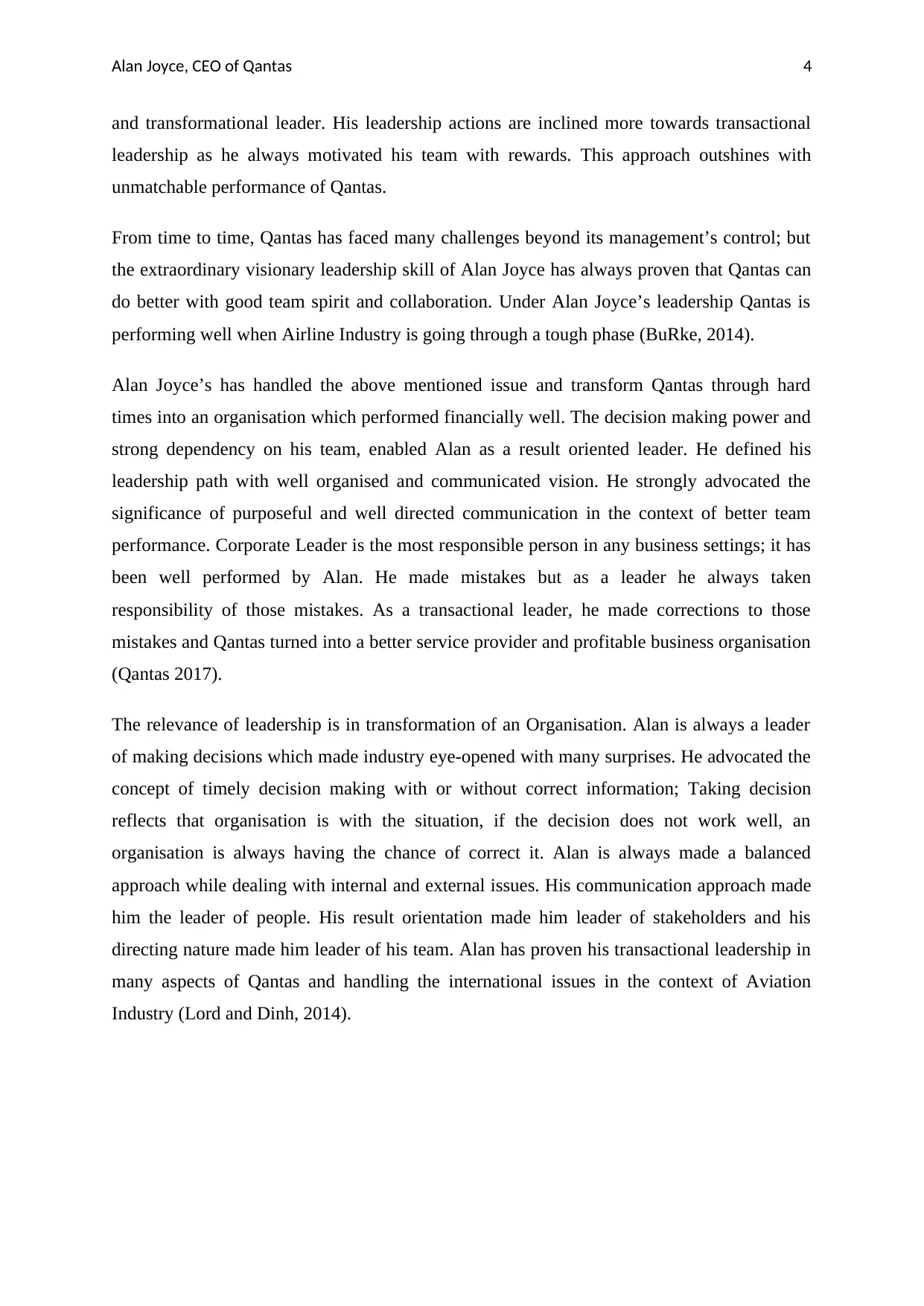
Alan Joyce, CEO of Qantas 4
and transformational leader. His leadership actions are inclined more towards transactional
leadership as he always motivated his team with rewards. This approach outshines with
unmatchable performance of Qantas.
From time to time, Qantas has faced many challenges beyond its management’s control; but
the extraordinary visionary leadership skill of Alan Joyce has always proven that Qantas can
do better with good team spirit and collaboration. Under Alan Joyce’s leadership Qantas is
performing well when Airline Industry is going through a tough phase (BuRke, 2014).
Alan Joyce’s has handled the above mentioned issue and transform Qantas through hard
times into an organisation which performed financially well. The decision making power and
strong dependency on his team, enabled Alan as a result oriented leader. He defined his
leadership path with well organised and communicated vision. He strongly advocated the
significance of purposeful and well directed communication in the context of better team
performance. Corporate Leader is the most responsible person in any business settings; it has
been well performed by Alan. He made mistakes but as a leader he always taken
responsibility of those mistakes. As a transactional leader, he made corrections to those
mistakes and Qantas turned into a better service provider and profitable business organisation
(Qantas 2017).
The relevance of leadership is in transformation of an Organisation. Alan is always a leader
of making decisions which made industry eye-opened with many surprises. He advocated the
concept of timely decision making with or without correct information; Taking decision
reflects that organisation is with the situation, if the decision does not work well, an
organisation is always having the chance of correct it. Alan is always made a balanced
approach while dealing with internal and external issues. His communication approach made
him the leader of people. His result orientation made him leader of stakeholders and his
directing nature made him leader of his team. Alan has proven his transactional leadership in
many aspects of Qantas and handling the international issues in the context of Aviation
Industry (Lord and Dinh, 2014).
and transformational leader. His leadership actions are inclined more towards transactional
leadership as he always motivated his team with rewards. This approach outshines with
unmatchable performance of Qantas.
From time to time, Qantas has faced many challenges beyond its management’s control; but
the extraordinary visionary leadership skill of Alan Joyce has always proven that Qantas can
do better with good team spirit and collaboration. Under Alan Joyce’s leadership Qantas is
performing well when Airline Industry is going through a tough phase (BuRke, 2014).
Alan Joyce’s has handled the above mentioned issue and transform Qantas through hard
times into an organisation which performed financially well. The decision making power and
strong dependency on his team, enabled Alan as a result oriented leader. He defined his
leadership path with well organised and communicated vision. He strongly advocated the
significance of purposeful and well directed communication in the context of better team
performance. Corporate Leader is the most responsible person in any business settings; it has
been well performed by Alan. He made mistakes but as a leader he always taken
responsibility of those mistakes. As a transactional leader, he made corrections to those
mistakes and Qantas turned into a better service provider and profitable business organisation
(Qantas 2017).
The relevance of leadership is in transformation of an Organisation. Alan is always a leader
of making decisions which made industry eye-opened with many surprises. He advocated the
concept of timely decision making with or without correct information; Taking decision
reflects that organisation is with the situation, if the decision does not work well, an
organisation is always having the chance of correct it. Alan is always made a balanced
approach while dealing with internal and external issues. His communication approach made
him the leader of people. His result orientation made him leader of stakeholders and his
directing nature made him leader of his team. Alan has proven his transactional leadership in
many aspects of Qantas and handling the international issues in the context of Aviation
Industry (Lord and Dinh, 2014).
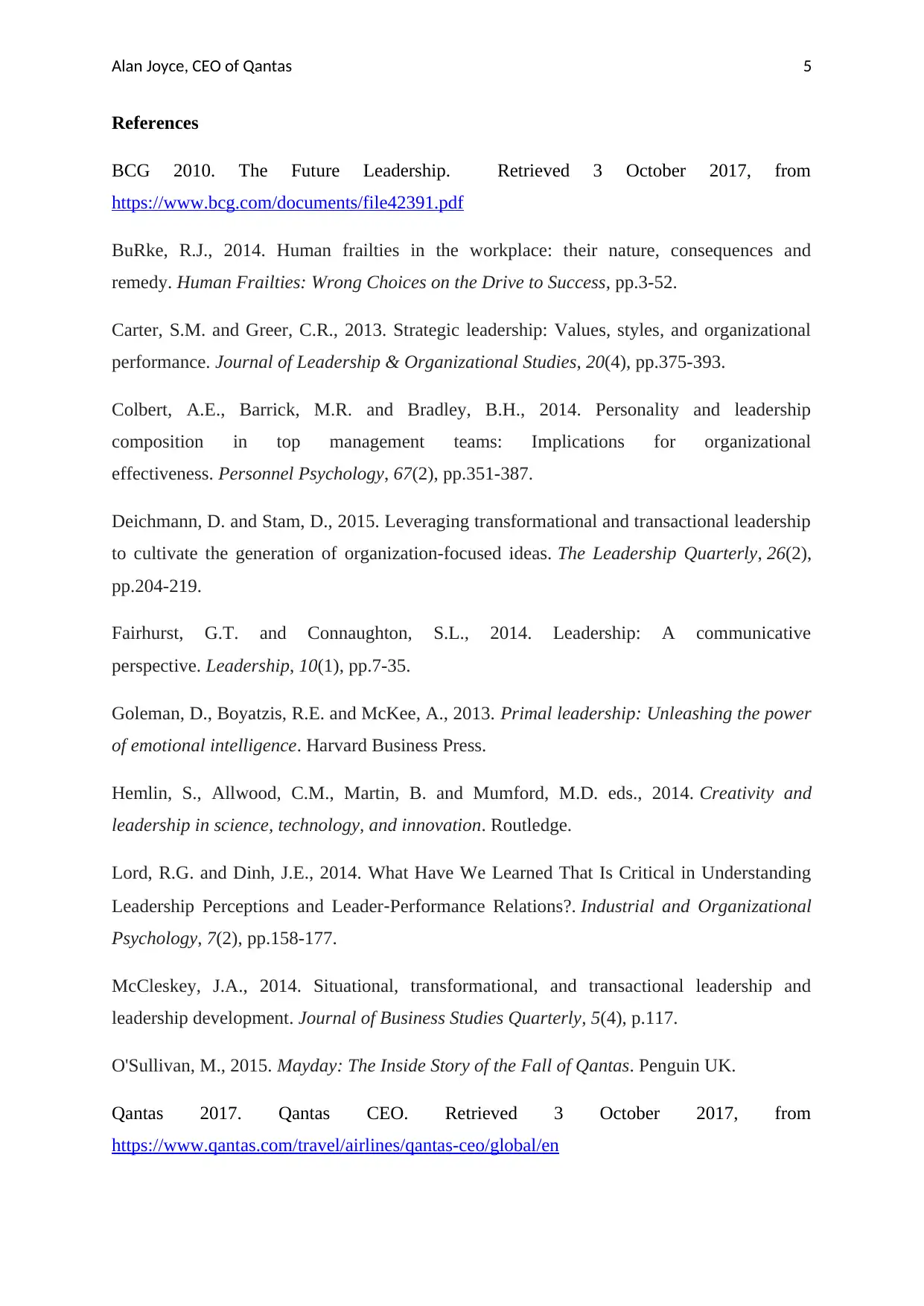
Alan Joyce, CEO of Qantas 5
References
BCG 2010. The Future Leadership. Retrieved 3 October 2017, from
https://www.bcg.com/documents/file42391.pdf
BuRke, R.J., 2014. Human frailties in the workplace: their nature, consequences and
remedy. Human Frailties: Wrong Choices on the Drive to Success, pp.3-52.
Carter, S.M. and Greer, C.R., 2013. Strategic leadership: Values, styles, and organizational
performance. Journal of Leadership & Organizational Studies, 20(4), pp.375-393.
Colbert, A.E., Barrick, M.R. and Bradley, B.H., 2014. Personality and leadership
composition in top management teams: Implications for organizational
effectiveness. Personnel Psychology, 67(2), pp.351-387.
Deichmann, D. and Stam, D., 2015. Leveraging transformational and transactional leadership
to cultivate the generation of organization-focused ideas. The Leadership Quarterly, 26(2),
pp.204-219.
Fairhurst, G.T. and Connaughton, S.L., 2014. Leadership: A communicative
perspective. Leadership, 10(1), pp.7-35.
Goleman, D., Boyatzis, R.E. and McKee, A., 2013. Primal leadership: Unleashing the power
of emotional intelligence. Harvard Business Press.
Hemlin, S., Allwood, C.M., Martin, B. and Mumford, M.D. eds., 2014. Creativity and
leadership in science, technology, and innovation. Routledge.
Lord, R.G. and Dinh, J.E., 2014. What Have We Learned That Is Critical in Understanding
Leadership Perceptions and Leader‐Performance Relations?. Industrial and Organizational
Psychology, 7(2), pp.158-177.
McCleskey, J.A., 2014. Situational, transformational, and transactional leadership and
leadership development. Journal of Business Studies Quarterly, 5(4), p.117.
O'Sullivan, M., 2015. Mayday: The Inside Story of the Fall of Qantas. Penguin UK.
Qantas 2017. Qantas CEO. Retrieved 3 October 2017, from
https://www.qantas.com/travel/airlines/qantas-ceo/global/en
References
BCG 2010. The Future Leadership. Retrieved 3 October 2017, from
https://www.bcg.com/documents/file42391.pdf
BuRke, R.J., 2014. Human frailties in the workplace: their nature, consequences and
remedy. Human Frailties: Wrong Choices on the Drive to Success, pp.3-52.
Carter, S.M. and Greer, C.R., 2013. Strategic leadership: Values, styles, and organizational
performance. Journal of Leadership & Organizational Studies, 20(4), pp.375-393.
Colbert, A.E., Barrick, M.R. and Bradley, B.H., 2014. Personality and leadership
composition in top management teams: Implications for organizational
effectiveness. Personnel Psychology, 67(2), pp.351-387.
Deichmann, D. and Stam, D., 2015. Leveraging transformational and transactional leadership
to cultivate the generation of organization-focused ideas. The Leadership Quarterly, 26(2),
pp.204-219.
Fairhurst, G.T. and Connaughton, S.L., 2014. Leadership: A communicative
perspective. Leadership, 10(1), pp.7-35.
Goleman, D., Boyatzis, R.E. and McKee, A., 2013. Primal leadership: Unleashing the power
of emotional intelligence. Harvard Business Press.
Hemlin, S., Allwood, C.M., Martin, B. and Mumford, M.D. eds., 2014. Creativity and
leadership in science, technology, and innovation. Routledge.
Lord, R.G. and Dinh, J.E., 2014. What Have We Learned That Is Critical in Understanding
Leadership Perceptions and Leader‐Performance Relations?. Industrial and Organizational
Psychology, 7(2), pp.158-177.
McCleskey, J.A., 2014. Situational, transformational, and transactional leadership and
leadership development. Journal of Business Studies Quarterly, 5(4), p.117.
O'Sullivan, M., 2015. Mayday: The Inside Story of the Fall of Qantas. Penguin UK.
Qantas 2017. Qantas CEO. Retrieved 3 October 2017, from
https://www.qantas.com/travel/airlines/qantas-ceo/global/en
1 out of 6
Your All-in-One AI-Powered Toolkit for Academic Success.
+13062052269
info@desklib.com
Available 24*7 on WhatsApp / Email
![[object Object]](/_next/static/media/star-bottom.7253800d.svg)
Unlock your academic potential
© 2024 | Zucol Services PVT LTD | All rights reserved.


